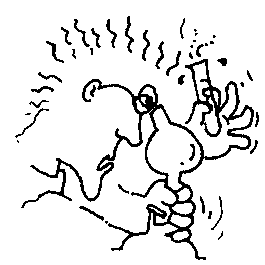
Insight and
Concentration

The next thing
that you need is to be able to differentiate between concentration
and mindfulness. It will determine the direction you are heading –
whether you are on the path to tranquility or insight development.
Most meditation
methods emphasize concentration. They bring the mind to focus on one
point or object, thereby achieving strength of concentration. The
results are very peaceful states, and in extreme cases give rise to
supernormal powers. Isn’t this what people are hoping to achieve?
No wonder most head towards that direction!
For Buddhists,
that way does not lead completely away from all our sufferings, although
it can lighten them considerably for a period of time. The answer
to the predicament is Insight, which is the realization of the real
Nature of the world as it is, freed from concepts. In simple words,
all mental and material processes that make up this world are really
impermanent, unsatisfactory and non-self. Seeing thus, one turns away
from them and finds refuge in the unconditioned state, the everlasting
peace of the absolute reality, Nibbana. Without realizing the unsatisfactory
state of conditioned existence, one is greatly attached to it and,
therefore, emancipation is impossible.
To develop this
Insight, mindfulness is emphasized as the main feature, and concentration
steps down to second place as another necessary factor.
To differentiate
between mindfulness and concentration we can quote their characteristics:
- Concentration
holds on to and fixes the mind to the object. It is like when you
are holding tightly to something and not letting go. It is also
like when you are staring at the television screen, unable to tear
yourself away from it.
- Mindfulness,
however, is like making a careful observation of what is happening
on the television screen.
In other words,
concentration pins the mind to its object, while it is mindfulness
that carefully and thoroughly gets a good look at it. When you have
found out what that thing really is, then you have developed insight
wisdom.
From here we can
conclude that concentration can come without mindfulness, but when
mindfulness is present, to some degree, there is concentration.
Normally in tranquillity
practice, although concentration is the main objective, there must
also be mindfulness to bring it about. But that mindfulness is not
as thorough as you would achieve in Insight meditation. Besides, its
objects differ, i.e. a conceptual one with tranquility practice.
If one’s
aim is to really look within, to discover who and what one really
is, then mindful observation must be borne in mind as the main factor.
Then one is like a scientist, making a close and thorough observation
of his subject. Once there is enough, one gets the full picture with
all its details. That is when mindfulness is transformed into insight.
So in insight meditation, one observes with concentrated awareness
on the objects, eg. rising/falling of the abdomen, sitting/touching,
pain, thinking, right foot/left foot, etc., and will soon discover
that all these (including the observing mind) are just processes that
arise and pass away so rapidly. The meditator then realises that all
these processes are changing (impermanent), beyond individual
control, and unsatisfactory. In insight meditation this also means
an abandoning of clinging to the false self, and there is a return
to original nature.
The abolishing
of the “I am” – that is truly supreme bliss.
~ Udana ~
Follow-up Advice
Welcome to my
favorite world. This world with nobody around, just mental and material
processes going on. This is what I find most meaningful. This is where
the real meaning of life is! When you are really aware of these things,
there’s no place for attachment, anger, hallucinations and all
those negative qualities. They just don’t fit in when one is
really aware of these things. There you are – the peace and meaning
to live by, and that is to discover the final journey within, to be
home with the absolute.

Unfortunately,
the scope of this little booklet is such that I can only give an introduction
to what Insight meditation is, and the basic exercises. There are
definitely many more steps to be taken and it will be best if you
approach the people who have done it before and are able to give you
suitable advice. It is, of course, preferable that you attend a more
complete course, under a qualified instructor, on a part-time basis
or at an intensive retreat.
For those who
are daring enough to try, using just the basic knowledge contained
in this booklet, I have one or two more things to say.
Firstly, these
minimal instructions are meant only for those without any serious
psychological problems. If one is under medication or treatment for
mental abnormalities, it is stressed further that this booklet is
insufficient. They have to get in touch with a qualified teacher.
Secondly, if one
gains concentration, one may meet with various experiences. There
may be joyful feelings, visions, voices, or even fear. The simplest
step is to note them mindfully. They should eventually subside
and pass away within a minute. Do not be attached or panic if they
don’t. If worst comes to worst, just open your eyes and get up.
Do this also if the mind goes into worse states of restlessness when
the sitting progresses after half an hour. This can happen when your
mind is burdened by tons of problems or unresolved issues. Do quick
walking instead. The principle is to be Mindful. If mindfulness does
not increase, but worsens instead, something is wrong.
Last, but not
least, seize an opportunity to attend an intensive course or retreat
on Insight (Vipassana) meditation. The progress and understanding
of the practice in a retreat of about ten days can be better than
that achieved in a period of one year, done by oneself on a daily
basis.
|

